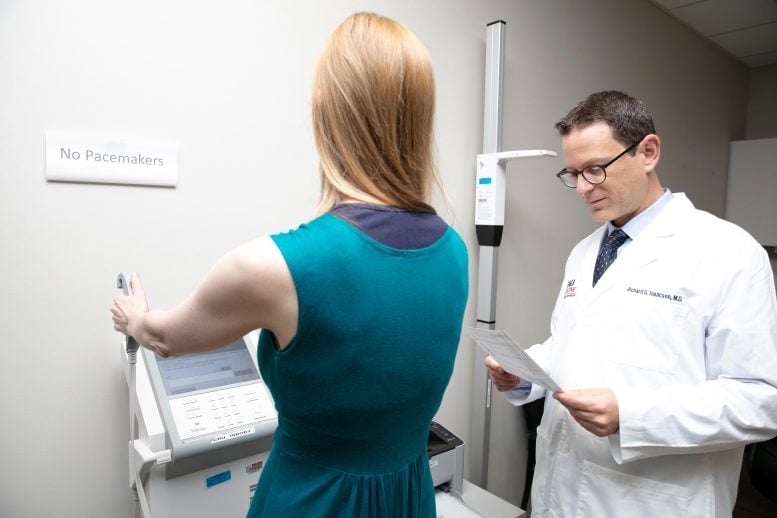
Even when accounting for gender-dependent mortality rates, age at death, and differences in lifespan, women still have twice the risk of Alzheimer’s disease. New research studied whether sex significantly affects cognitive outcomes in people who follow individually-tailored, multi-domain clinical interventions.
Richard Isaacson, M.D., leads first study to define sex differences in outcomes of tailored Alzheimer’s disease clinical interventions.
After increasing age, the most significant risk factor for Alzheimer’s disease (AD) is sex – two-thirds of patients with AD are females. In fact, even when accounting for gender-dependent mortality rates, age at death, and differences in lifespan, women still have double the risk of incidence.
A study headed by Florida Atlantic University’s Richard S. Isaacson, M.D., a leading neurologist and researcher, and collaborators from NewYork-Presbyterian/Weill Cornell Medicine, is the first to examine if sex significantly affects cognitive outcomes in people who follow individually-tailored, multi-domain clinical interventions. The research also determined whether change in risk of developing cardiovascular disease and AD, along with blood markers of AD risk, also were affected by sex. Other studies have focused on the role of hormones and sex-specific risk factors when examining differences in AD risk, but none have explored if these interventions result in differences in real-world clinical practice.
The study is an analysis of the Comparative Effectiveness Dementia & Alzheimer’s Registry (CEDAR) trial launched at Weill Medicine in 2015 and spearheaded by Isaacson, which has already demonstrated that individualized, multi-domain interventions improved cognition and reduced the risk of AD in both women and men.
In the sub-group analysis, researchers evaluated the differential effectiveness of the clinical approach itself when considering sex in higher-compliance participants (n=80) from the original study cohort (n=154). Within this cohort, similar to the original study, participants were categorized by baseline diagnoses: normal cognition, subjective cognitive decline, and preclinical AD participants were classified as “Prevention.” Mild cognitive impairment due to AD and mild AD were classified as “Early Treatment.”

Richard Isaacson, M.D., director, Alzheimer’s Prevention Clinic in the Center for Brain Health at FAU’s Schmidt College of Medicine, measures a patient’s percentage of body fat and muscle mass over time to evaluate response to therapies and help refine exercise and nutrition plans. Credit: Florida Atlantic University
Results of the study, published in the Journal of Prevention of Alzheimer’s Disease on April 26, 2022, showed that risk reduction care in an Alzheimer’s Prevention Clinic setting led to improvements in cognition in both women and men without sex-differences. However, in the Prevention group, women demonstrated greater improvements in the Multi-Ethnic Study of Atherosclerosis risk score (MESA) than men. Women in the Early Treatment group also demonstrated greater improvements in CV Risk Factors, Aging and Incidence of Dementia (CAIDE) risk score and the MESA-RS. The CAIDE is a validated risk index that calculates late-life dementia risk based on midlife vascular risk factors such as body mass index, blood pressure, cholesterol, and smoking status, while the MESA estimates one’s risk of cardiovascular disease incidence over the next ten years using traditional risk factors.
“Our latest results suggest that the individualized management approach used by the CEDAR study in a real-world clinic may offer equal cognitive benefits to both women and men, as well as better mitigation of calculated Alzheimer’s disease and cardiovascular disease risk in women compared to men.” — Richard S. Isaacson, M.D.
“While care in an Alzheimer’s Prevention Clinic setting is equally effective at improving cognitive function in both women and men, our personally-tailored interventions led to greater improvements in women compared to men across Alzheimer’s and cardiovascular disease risk scales, as well blood biomarkers of risk such as blood sugar, LDL cholesterol, and the diabetes test HbA1C,” said Isaacson, lead author and director of the newly launched FAU Center for Brain Health and the Alzheimer’s Prevention Clinic within the Schmidt College of Medicine, who conducted the study while at Weill Cornell Medicine and NewYork-Presbyterian. “Our findings are important because women are disproportionately affected by Alzheimer’s disease and population-attributable risk models suggest that managing risk factors can prevent up to one-third of dementia cases, highlighting the immense potential that lies in addressing modifiable risk factors.”
After undergoing baseline clinical assessments, which included a detailed clinical history, physical examination, anthropometrics, blood biomarkers, apolipoprotein-ε4 (APOE-e4) genotyping, and cognitive assessment, patients in the CEDAR study were given individually-tailored, multi-domain intervention recommendations informed by these clinical and biomarker data. Recommendation categories included patient education/genetic counseling, individualized pharmacological approaches (medications/vitamins/supplements), non-pharmacological approaches (exercise counseling, dietary counseling, vascular risk reduction, sleep hygiene, cognitive engagement, stress reduction, and general medical care), and other evidence-based interventions.
“Our latest results suggest that the individualized management approach used by the CEDAR study in a real-world clinic may offer equal cognitive benefits to both women and men, as well as better mitigation of calculated Alzheimer’s disease and cardiovascular disease risk in women compared to men,” said Isaacson. “Our work also highlights the need for larger studies focusing on sex differences in AD-related cognitive trajectories, as the existing body of knowledge lacks conclusive evidence on this issue.”
Isaacson and collaborators are planning on larger cohorts to further define sex differences in AD risk reduction in clinical practice and hope to launch a multi-site international study soon to draw more definitive conclusions.
Reference: “Sex-Driven Differences in the Effectiveness of Individualized Clinical Management of Alzheimer’s Disease Risk” by N. Saif, H. Hristov, K. Akiyoshi, K. Niotis, I. E. Ariza, N. Malviya, P. Lee, J. Melendez, G. Sadek, K. Hackett, A. Rahman, J. Meléndez-Cabrero, C. E. Greer, L. Mosconi, R. Krikorian and Richard S. Isaacson, 26 April 2022, The Journal of Prevention of Alzheimer s Disease.
DOI: 10.14283/jpad.2022.44
Collaborators of the study include FAU’s Schmidt College of Medicine; Cleveland Clinic; Lou Ruvo Center for Brain Health, Las Vegas; Jersey Memory Assessment Service, Jersey, United Kingdom; Alzheimer’s Prevention Clinic & Research Center of Puerto Rico, San Juan; Weill Cornell Medicine & NewYork-Presbyterian; New York; Norton Neuroscience Institute, Louisville; McGill University Faculty of Medicine, Montreal, Canada; University of New South Wales/University of Notre Dame, Sydney, Australia; and Atria Institute, New York.
The study was primarily supported by the Women’s Alzheimer’s Movement with additional support from the Altman Family Fund, Zuckerman Family Foundation Ace’s for Alzheimer’s, the Harry T. Mangurian, Jr. Foundation, philanthropic support from the patients of the Alzheimer’s Prevention Clinic at Weill Cornell Medicine, the National Institutes of Health (NIH), and the National Center for Advancing Translational Research (UL1TR002384) and NIH (PO1AG026572).









Be the first to comment on "Men and Women Are Not Created Equal When It Comes to Preventing Alzheimer’s Disease"